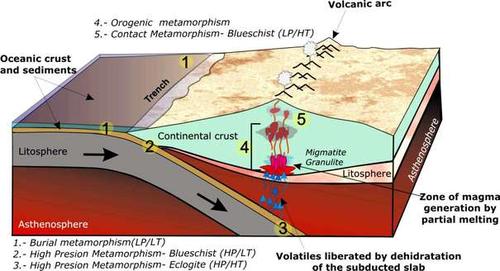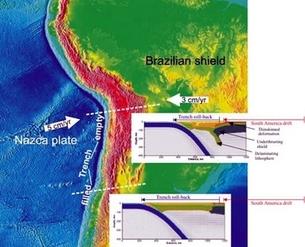1. Subduction
Development of a orogenic belt at an active continental margin
Image Credit: MBG
Surface topography and major structural features of the Andes subduction system. The trench adjacent to the high central Andes has no sedimentary fill, which may increase friction in the subduction channel.
Image Credit: Sobolev wp modelling deformation at plate boundaries
With respect to metamorphism, the most important feature of subduction zones is their low heat flow. The main model for subduction-zone metamorphism therefore includes three classes: 1. High-pressure metamorphism takes places in rocks which are part of the down-going slab; 2. Some metamorphism occurs in material that has been accreted to the base of the overlying plate; 3. The high-pressure rocks are incorporated into the upper plate by a shift in the location of the Benioff zone. The accretion of high-pressure metamorphic rocks, formed as part or the downgoing plate, on to the base of the overlying plate requires subcretion (i.e. tectonic underplating). A model for the sequential development of an orogenic belt at an active continental margin without collision must consider: A.- incipient stages of subduction; B.- an orogenic welt is created by crustal thickening due to compression, thrust stacking of oceanic slices, and/or addition of magmatic material from below. Underthrusting of oceanic crust in the forearc area may migrate trenchward, adding successive slabs to the base of the outer welt. Heat is added to the growing welt by rising plutons, underplated magmas, increased radioactive heat generation in the thickened enriched crust, and induced mantle convection in the mantle wedge above the subducted slab. Temperature increases both downward and toward the axial portion of the welt where plutons are concentrated. Resulting metamorphism is widespread. Deep-seated rocks may become heated to the point of melting. They may become sufficiently ductile to be mobilized, rising into the extending welt as “gneiss domes” or “metamorphic core complexes” (examples in the Lepontine Alps, Adirondack Mountains of the northeastern US and parts of the North American Cordillera). Uplift of the thickening welt and erosion results in advective heat transfer upward and exposure of the metamorphic rocks. Because heat dissipates slowly, metamorphism generally continues even after major deformation ceases. When this occurs, the metamorphic pattern is simpler than the structural one. In such cases, the folding and thrusting may be complex, but the metamorphism exhibits a simple domal pattern, centering on the metamorphic/igneous core where heat input was the highest. Subsequent erosion will be nearly proportional to uplift, leaving an exposed surface pattern of increasing metamorphic grade from both directions toward the core area. The above-described history is a simplified example. Most orogenic belts have several episodes of deformation and metamorphism, thus creating a more complex polymetamorphic pattern.
Uplift of the thickening welt and erosion, results in advective heat transfer upward and exposure of the metamorphic rocks. Because heat dissipates slowly, metamorphism generally continues after major deformation ceases. When this occurs, the metamorphic pattern is simpler than the structural one. In such cases, the folding and thrusting may be complex, but the metamorphism exhibit a simple domal pattern, centering on the metamorphic/igneous core where heat input were the greatest. Subsequent erosion will be nearly proportional to uplift, leaving an exposed surface pattern of increasing metamorphic grade from both directions toward the core area. This is a very simplified example, and most orogenic belts have several episodes of deformation and metamorphism, thus creating a more complex polymetamorphic pattern.

